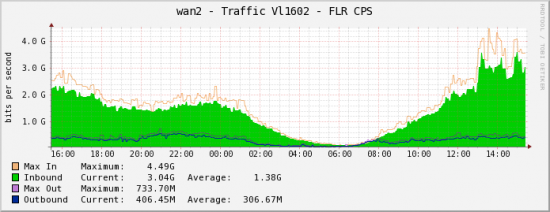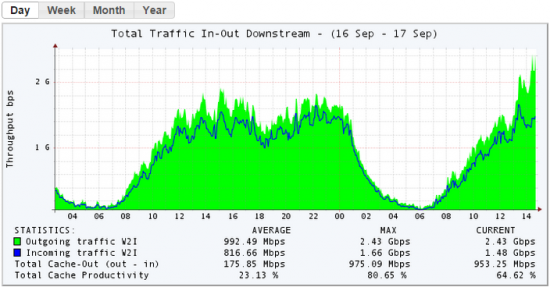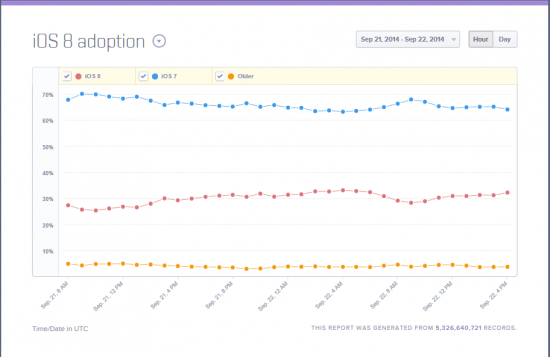































Many network engineers recall the iOS7 update on September 18, 2013 as one of the most historic download days of their network's history. All the more reason for us in the wireless world who anxiously anticipated the September 17 release of iOS8.
We asked a few of our customers to monitor the effect of the software release on their networks and the results for the first two days are in. Those in the education and healthcare space in particular are filled with early adopters of WiFi technology and devices, and eager to get their hands on the latest updates.
Joe Rogers, Associate Network Director at the University of South Florida shared this picture with us from 1pm September 17th, showing 1 Gbps more traffic than he would normally see at this time of day:

Another customer, Greg Sawyer, Manager of Infrastructure Services, shared this picture of the iOS8 effect on his network at the UNSW Australia.

He noted that his experience handling the release this year felt smoother than last year, despite the new peak internet download of 4.65 Gbps and 21Tb downloaded for the day! Not too surprising when considering that there were 27,000 concurrent connections on the wireless network and approximately 60% of those being Apple devices.
How should organizations be considering and handling these network spikes? I sat down with Cisco technical leaders Matt MacPherson and Chris Spain (@Spain_Chris) to get some insight on the effect of big updates like iOS8 on the wireless network. Here are some of the highlights of what we discussed:
The World We Live In
The truth is, more and more services are being moved to the cloud-a cloud that will push updates to millions & in the future billions of users and devices on our networks.Whether it's a new operating system (iOS, Windows, Chrome, Android), regular application updates (Microsoft Office, Minecraft); Patch Tuesday or security fixes, these network spikes are becoming more and more common, and the network engineer must either evolve or forever be behind. The key to keeping up with this cloud-driven world is in network design.
Design Networks with these Bursts in mind
A well designed 802.11n or 802.11ac WiFi network can handle big updates with ease.
Internet traffic has always been bursty, rather than predictive. While average throughput can appear to be modest, the bursts are significant and should be planned for. Just like a utility over-provision and undersubscribe to provide an optimal user experience.
If designed properly, meaning minimizing the overhead tax, getting reasonable throughput and eliminating lower data rates, even if you experience a 50% increase in throughput, the network should absorb it.
Arm Yourself with Best Practices
If you do not have a network designed to deliver pervasive mobility, you need one. Else you face constipated, low performing network and the wrath of angry end users. Two good resources to start with are the Cisco High Density Design Guide and this Cisco WLAN Best Practices Design Guide.
Don't Forget the WAN & Internet connections
With these updates being initiated from the cloud the Wide Area Network bears the brunt of the load and is the bottleneck for updates especially when there is a large user community. Hence proper planning for these peaks in traffic is key.
Our partnership with Akamai affords our joint customers the ability to cache Apple iOS upgrades thereby saving expensive WAN bandwidth. The caching technology helps by eliminating updates being sent over the wide area network multiple times.
In the words of Joe Rogers, "Fortunately for us, Akamai chose to send our traffic to caches on our state optical network where we have plenty of available capacity. So far this has been a much more pleasant roll out than iOS7."
Consider Policy, Understand Human Nature
Many a network engineer will wonder "Can't I just block the updates?" You may certainly try. Many organizations will try to block updates like iOS8 to reserve their bandwidth for more mission-critical applications, others want the time to check the operation and security of business-critical applications-but where there is a will, there is a way and more likely than not, the new updates will likely find their way around your policies and you have to deal with it sooner or later. Take our own Cisco IT department for example: the official policy was "wait for the green light before updating to iOS8" yet as of the morning of September 18, there were 3800 iOS8 devices on the Cisco network, ahead of the all clear to upgrade signal.
The truth is, adoption is very fast -MixPanel shows 18% on the first day.

For the early adopters , the Cisco AireOS 8.0 release supports the Application Visibility and Control protocol pack 11. This allows for IT administrators to identify how much traffic in your network is due to Apple App Store, Apple iOS updates and AppleTV Updates among several others.

Bottom Line
As the world moves to the cloud, updates are going to be more and more common-meaning spikes will also happen more frequently. You need to plan for these events with a well-designed WiFi network. If you don't know how, learn. We have resources just for that purpose: design guides and best practices.
How is the iOS8 update affecting your network?
 Hot Tags :
#Security
#Cloud
802.11ac
11ac
802.11
8.0
aireOS
Akamai
802.11n
Hot Tags :
#Security
#Cloud
802.11ac
11ac
802.11
8.0
aireOS
Akamai
802.11n